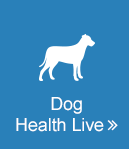The liver’s main functions are to filter blood from the GI tract before it goes into the rest of the bloodstream, produce bile to aid in fat digestion and to store glycogen as a source of energy. Age, infection, trauma, toxins, diseases like diabetes and side effects of medications can all inhibit liver function.
Healthy liver function affects many systems in the body so when it is not working properly it can cause a lot of problems. Liver disease and liver failure can be recognized by decreased appetite, vomiting, diarrhea, weight loss, lethargy, increased drinking/urinating, confusion, and seizures. Jaundice (yellowing of the skin and eyes) is a major tell-tale sign of liver problems, but is difficult to recognize on furry dogs. Take a look at the area around your dog’s belly where the fur in thin to see their skin color.
The vet can feel if the dog’s liver is enlarged and run bloodwork to make sure the liver is healthy. Fluid & nutritional support can often put the liver back into balance when treated early. Bacterial infections can be treated by your vet with antibiotics and the liver can be supported with supplements like milk thistle extract and SAMe. Dogs with sensitive livers do best on gentle diets that are low in fat & protein, but high in digestible carbs like rice and pasta. Not all types of liver disease are treatable, but your vet can provide lots of options to support your dog to keep them comfortable and happy.
Studies
Hepatic progenitor cells in canine and feline medicine: potential for regenerative strategies.
Animal models of fulminant hepatic failure: a critical evaluation.
Evaluation of a semiquantitative SNAP test for measurement of bile acids in dogs.
Canine hepacivirus is not associated with chronic liver disease in dogs.


